Related Research Articles
Werra-Meißner is a Kreis (district) in the north of Hesse, Germany. Neighboring districts are Göttingen, Eichsfeld, Unstrut-Hainich-Kreis, Wartburgkreis, district-free Eisenach, Hersfeld-Rotenburg, Schwalm-Eder-Kreis, Kassel.

Graf is a historical title of the German nobility, usually translated as "count". Considered to be intermediate among noble ranks, the title is often treated as equivalent to the British title of "earl".
Wartburgkreis is a Kreis (district) in the west of Thuringia, Germany. Neighboring districts are the districts Unstrut-Hainich-Kreis, Gotha, Schmalkalden-Meiningen, and the districts Fulda, Hersfeld-Rotenburg and Werra-Meißner-Kreis in Hesse.
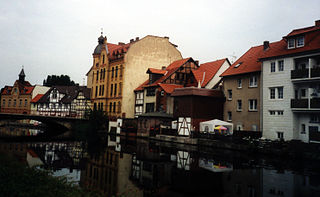
Eschwege, the district seat of the Werra-Meißner-Kreis, is a town in northeastern Hesse, Germany. In 1971, the town hosted the eleventh Hessentag state festival.
Hesse-Rotenburg is a former German landgraviate created from the landgraviate of Hesse-Cassel in 1627. Its independence ended in 1834 when the estates not bequeathed to princes Victor and Chlodwig of Hohenlohe-Waldenburg-Schillingsfürst were reunited with Hesse-Kassel.
Bilstein may refer to:
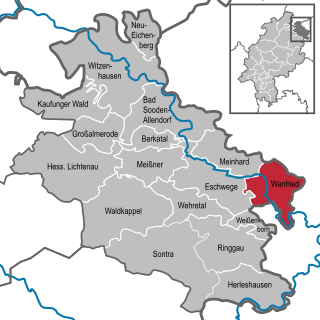
Wanfried is a town in the Werra-Meißner-Kreis in northeasternmost Hesse, Germany. It is classified as a Landstadt, a designation given in Germany to a municipality that is officially a town (Stadt), but whose population is below 5,000. It literally means “country town”.

The House of Henneberg was a medieval German comital family (Grafen) which from the 11th century onwards held large territories in the Duchy of Franconia. Their county was raised to a princely county in 1310.
Wigger I was the father of a line of counts ruling from his new castle of Bilstein, west of Albungen to the Werra. The counts of Bilstein played a prominent role in Thuringia from 967 to 1301 and were third after the Ekkehardinger and Weimar-Orlamünde in terms of power and influence.
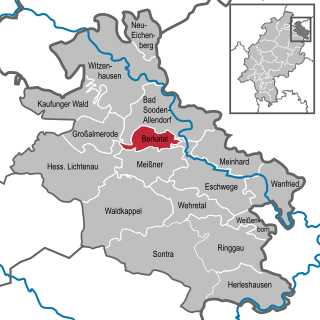
Berkatal is a municipality in the Werra-Meißner-Kreis in Hesse, Germany.

Herleshausen is a municipality in the Werra-Meißner-Kreis in Hesse, Germany.
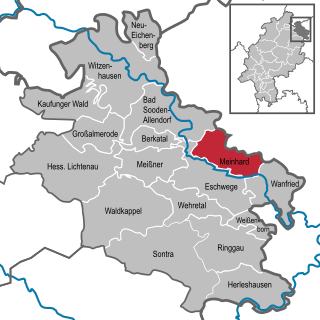
Meinhard is a municipality in the Werra-Meißner-Kreis in Hesse, Germany.

Meißner is a municipality in the Werra-Meißner-Kreis in Hesse, Germany.

Cornberg is a municipality in Hersfeld-Rotenburg district in northeastern Hesse, Germany. It is the district's smallest municipality.
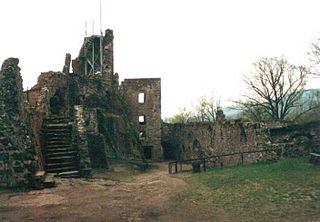
Hohnstein Castle is one of the largest and best-preserved castle ruins in Germany and is located near Neustadt in the vicinity of Nordhausen in Thuringia.

The House of Stolberg is the name of an old and large German dynasty of the former Holy Roman Empire's high aristocracy. Members of the family held the title of Fürst and Graf. They played a significant role in feudal Germany's history and, as a mediatized dynasty, enjoyed princely privileges until the collapse of the German Empire in 1918. The house has numerous branches.

Countess Juliane of Nassau-Siegen, German: Juliana Gräfin von Nassau-Siegen, official titles: Gräfin zu Nassau, Katzenelnbogen, Vianden und Diez, Frau zu Beilstein, was a countess from the House of Nassau-Siegen, a cadet branch of the Ottonian Line of the House of Nassau, and through marriage landgravine of Hesse-Kassel.

Landgrave Frederick of Hesse-Eschwege was from 1632 until his death Landgrave of the apanage of Hesse-Eschwege, which stood under the suzerainty of Hesse-Kassel.
Giso IV, Count of Gudensberg was a German nobleman. He was a Count in the Upper Lahngau and from 1121, he was Count of Gudensberg in Lower Hesse and Imperial Standard Bearer. During his lifetime, the Gisones dynasty reached the peak of its power, its largest territorial expanse and the largest number of bailiff positions.

Jestädt is a borough of the Municipality of Meinhard in the Werra-Meißner-Kreis in the State of Hesse of Germany.
References
- ↑ Raymund Falk (1993), Verein für Eichsfeldische Heimatkunde (ed.), "Die Wüstung Reichensachsen bei Heyerode und die Besiedlung der Hainich-Mittelgebirgslandschaft", Eichsfeld-Jahrbuch (in German), Duderstadt: Mecke Druck und Verlag, vol. Heft 1, pp. 151–155 (Abschnitt zur «Erphol-Schenkung»)
- ↑ Rudolf Knappe (2000), "«Bilstein» Gem. Albungen, Eschwege", Mittelalterliche Burgen in Hessen (in German), Gudensberg-Gleichen: Wartberg-Verlag, pp. 60–61, ISBN 3-86134-228-6
- ↑ Walter Heinemeyer (1992), Historische Kommission für Hessen (ed.), "Das Marburger Landgrafenschloß und die Wartburg - Marburg und Eisenach", Hessen und Thüringen - von den Anfängen bis zur Reformation. Eine Ausstellung des Landes Hessen (in German), Wiesbaden, vol. Katalog, p. 41, ISBN 3-89258-018-9
- ↑ Deed dated 14 May 1301 in the Marburg State Archives: Count Otto of Bilstein sold to Landgrave Henry his enfeoffed estates in (Lower) Hesse (Hassia) from the rivers Werra (Gewerra) to the Forest of Hecheno Archived 2014-09-03 at the Wayback Machine .
- ↑ Counts of Honstein-Ilfeld at Genealogie-Mittelalter.de